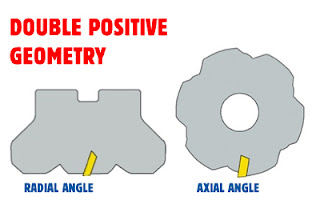In determining the most effective way to separate chips from your workpiece, several variables must be taken into consideration; however, probably the most important is selecting the right cutting tool geometry. After all, the collective angles formed by the dimensions of a cutting tool are what make a tool geometrically unique.
When it comes to your metal cutting operations, you have three general milling cutter geometries from which to choose: double positive geometry, double negative geometry and positive/negative geometry. Each of these geometries serves its own unique purpose as well as features its own set of advantages and disadvantages. Let’s see how each one might apply to you.
Double positive cutters hold the inserts in a way that creates a positive rake angle both axially and radially, allowing for very free cutting and clean, quiet machining. It’s an arrangement that also minimizes work hardening of the surface, achieves excellent surface finish as well as generates very little cutting force.
These geometries are good for machining non-ferrous materials, such as aluminum, copper and non-metallic materials, and even steels on smaller machines with limited power ratings. Care with the set-up is particularly important with these cutters as they are more fragile (leading to cutting edge chippage) and can lift the workpiece from the table.
Overall Advantages
Smooth cutting
Good chip removal
Good surface smoothness
Overall Disadvantages
Cutting edge strength
Unfavorable entry contact
Draws workpiece away from the machine table
Double Negative Geometry
Double negative cutters have an orientation that uses a combination of negative axial and negative radial rake angles, which direct the cutting forces further back from the edge of the insert.
This characteristic enables double negative cutters to show increased insert strength over the double positive and positive/negative cutters. However, while double negative cutters are very strong and rugged, their geometry can result in ineffective chip flow and potential issues with clogging.
While double negative geometries are ideal for cast iron, it’s imperative you have a machine with sufficient power, as well as a rigid setup for the firm mounting of your cutting tool and workpiece. Also, keep in mind that modern technology has made it possible to add chip breakers to inserts, allowing today’s negative rake cutters to machine more freely than ever before. Because of this, double negative cutters can effectively machine all materials as long as you utilize the correct chip groove profile.
Overall Advantages
Cutting edge strength
Productivity
Pushes the workpiece towards the machine table
Negative inserts double the number of cutting edges that can be used
Overall Disadvantages
Large cutting forces
Chip obstruction
Positive/Negative Geometry
Positive/negative cutters have an orientation that uses a combination of a positive axial rake angle and a negative radial rake angle. These cutters are the most popular because they offer some of the free cutting benefits of a double positive cutter and some of the strength of a double negative cutter.
The positive axial rake lifts the chips, while the negative radial rake directs them outward. These actions, when paired with a high lead angle, help reduce or eliminate chip flow obstructions.
Overall Advantages
Good chip removal
Favorable cutting forces
Wide range of applications
Metal cutting is not a one-size-fits-all type of process. We have literally dozens of milling cutters and hundreds of inserts from which to choose. If you have questions as to what type of insert geometry is the most effective choice for your particular application, please don’t hesitate to contact me.
About the Author
Bob works closely with Seco customers, helping them optimize their tool usage and find ways to increase their productivity and reduce costs. Contact Bob at bwinegard@secotools.com.
Metal cutting is not a one-size-fits-all type of process. We have literally dozens of milling cutters and hundreds of inserts from which to choose. If you have questions as to what type of insert geometry is the most effective choice for your particular application, please don’t hesitate to contact me.
About the Author
Bob works closely with Seco customers, helping them optimize their tool usage and find ways to increase their productivity and reduce costs. Contact Bob at bwinegard@secotools.com.



